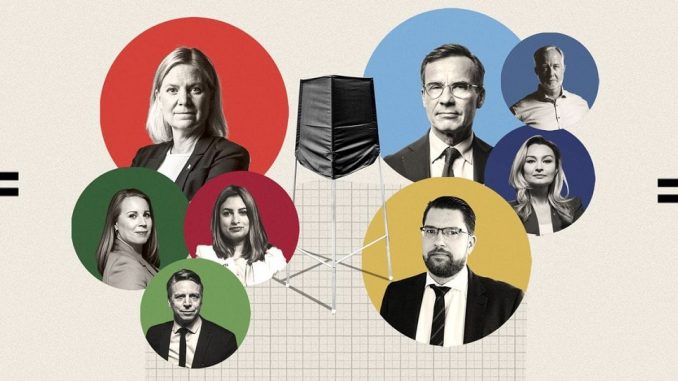
By Sergio Galarce
The final results of the tight elections of September 11 will be known on Wednesday 14, giving way to the formation of a new government, which could be right-wing. It will take “one step in parliament and a thousand walking in the streets and squares”.
The worldwide deep economic, social and military crisis that the capitalist system and its administration in the hands of bourgeois or social democratic parties is going through does not necessarily lead to a shift to the left when elections are held. This has been demonstrated in Sweden this September 11.
Results of the provisional count
Social Democracy obtained 30.5%, this is an increase of 2.2% compared to the 2018 elections, the extreme right (Sverigedemokraterna) 20.6% with which it grew again by 3.1% compared to 2018, the Conservatives (Moderaterna) with 19.1% which leads them to decrease by 0.7%, the party of the agrarian bourgeoisie (Centerpartiet) obtains 6.7% with which it falls back by 1.9%. The Greens (Miljöpartiet) obtain 5.0% which means an increase of 0.6%, the Left Party (Vänsterpartiet) obtains 6.6% of the total vote which means a decrease of 1.4%. The Christian Democrats (Krisdemokraterna) obtained 5.4%, which translates into a decrease of 0.9%, and finally the Liberal Party with 4.6% and also a decrease of 0.9%.
Social democracy and the consequences of its policies
The capitalist crisis, fueled by an ongoing war and the resulting militarism, has brought with it, among other things, rising inflation at the European level. The neoliberal policy implemented in Sweden by social democracy in collaboration with sectors of the right during these last four years has further paved the way for the advance of the extreme right. It is a trend to which almost all right-wing parties and social democracy have adapted.
Xenophobic and chauvinist speeches
The mass media have long nurtured the “radical” role of the far right. Since neither the right wing nor social democracy can point to the permanent crisis of capitalism as the root of the existing problems, they have to look for a scapegoat and that’s immigrants’ role, who have been linked to the existing criminality. This undoubtedly favored the xenophobic card of racism.
The extreme right wing’s targeting of immigrants is not new in Europe. To the xenophobia of the extreme right was added the chauvinist patriotism that in these elections has embraced almost all political parties. This had been clear for more than a year and deepened with force at the end of the election campaign, when the right and social democracy competed like crazy for who would present the most abhorrent proposals against racialized people. This led the extreme right to strengthen its populism and xenophobia.
The adaptation of Vänsterpartiet
It is strange that in such field only Annie Lööf (the leader of the agrarian bourgeois party) raised an anti-racist profile, but maintained an economic policy against the interests of the workers. Arguably, it is also strange that Vänssterpartiet did not take this situation as a starting point to raise the banner of anti-racism from the very beginning of the election campaign. However, the latter is not so strange. At the pre-election congress, where the party’s electoral line was defined, the Vänsterpartiet leadership was opposed to raising a clear anti-racist profile, despite all indications that the right wing was seeking to capitalize on immigration policy. Moreover, key issues voted by the pre-election congress were ignored in favor of an orientation towards the more depopulated and out-of-town areas and industry in an attempt to attract the vote of people whose dissatisfaction with the current state of affairs led them to see the populist far right as an alternative. This explains why Vänsterpartiet adapted to this and did not have a clearly anti-racist and environmentalist profile which led it to blur its own identity as an ecological left. Vänsterpartiet therefore did not have a political orientation for important sectors of immigrant workers or those with an immigration background, who today constitute a considerable part of the modern working class. That objective failed and also did not help to outvote Centerpartiet. This partially explains the electoral decline (1.4%) of Vänsterpartiet in these elections compared to the 2018 elections.
Reactionary forces could form a government
The clear winner in these elections is the extreme right wing that raised the chauvinist and racist flag. Formally, there was almost a tie between two “blocs” and the right will be able to form a government with the support of the extreme right, which is very serious. This takes place despite the fact that the liberal party promised during the campaign that it would not contribute with its seats so that the ultra-right would play a decisive role in the budgets of a right-wing government. But what is substantial is that the advance of the extreme right, which has set back almost the entire political spectrum, objectively strengthens the reactionary forces, and most likely this will be crowned with a new victory of post-fascism in Italy, where the elections will be held on Sunday, September 25.
100% left-wing, no room for lukewarm measures
On the positive side, the progressive forces, and in particular the Vänsterpartiet adherents, made significant gains in Sweden’s three largest cities – Stockholm, Gothenburg and Malmö. If we look at it from a class point of view, the left now faces the task of organizing resistance to the renewed offensive of the bourgeoisie and its new government. Here the task of the left must be to transform itself into a 100% left. There is no room for lukewarm measures, the left must start from the needs of the working class as a whole, climate change, anti-racism and the strengthening of feminism and the social movements, which means assuming a consistently socialist and internationalist position. This can be summarized as follows: one step in the parliament and a thousand walking in the streets and squares.








